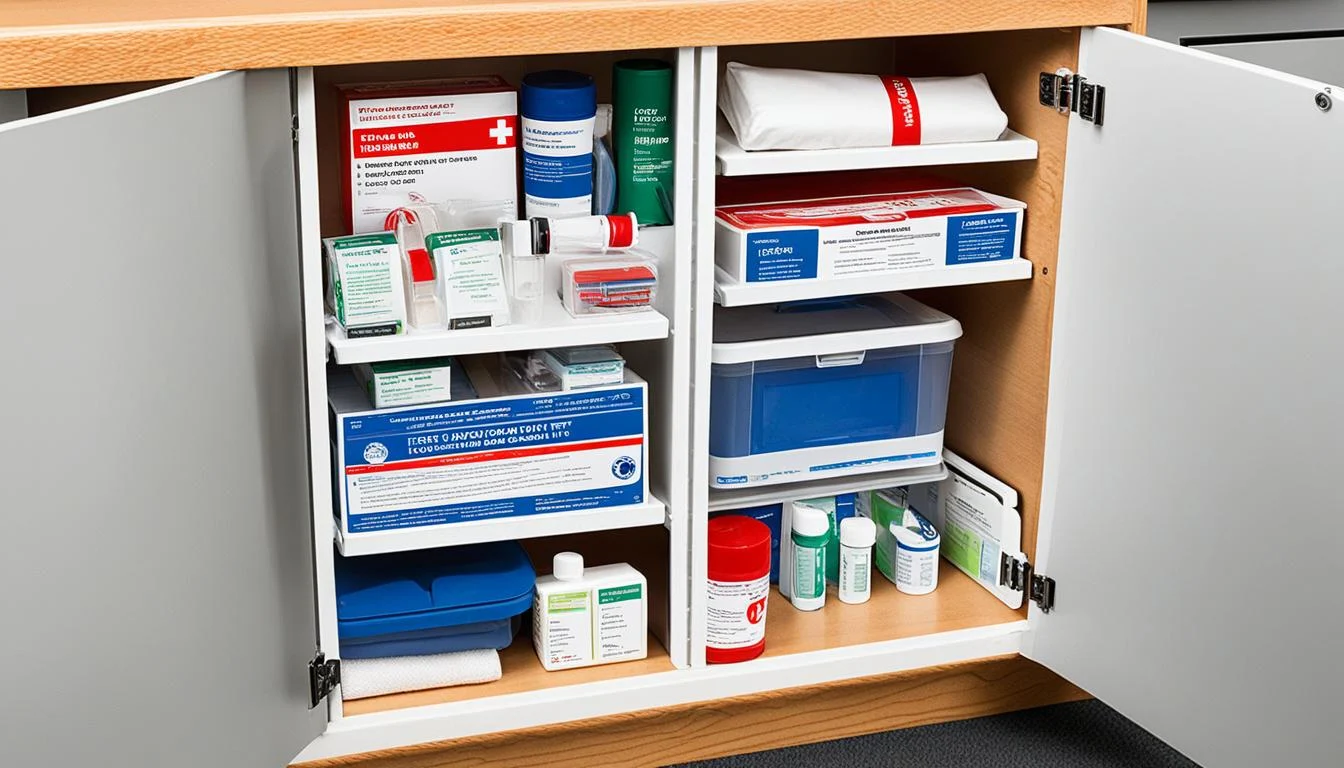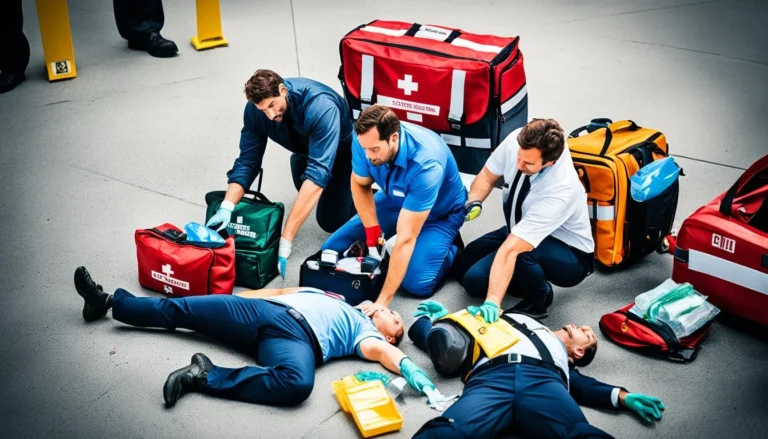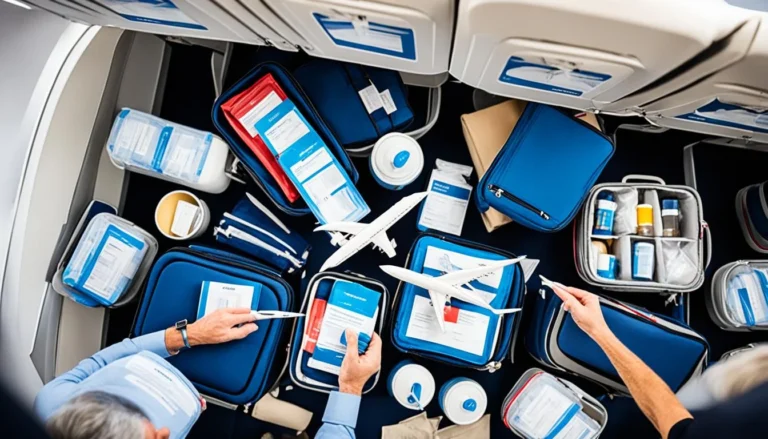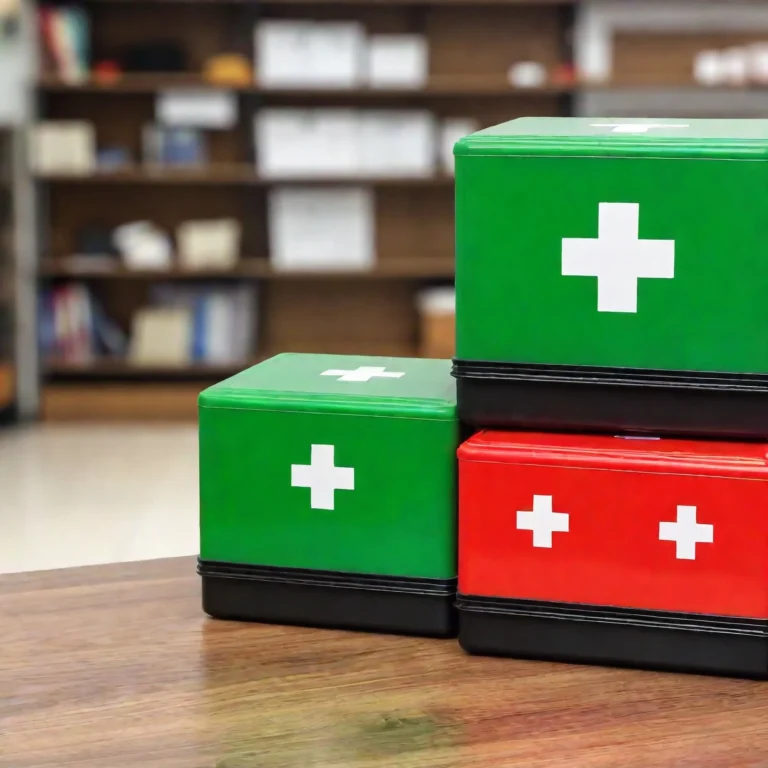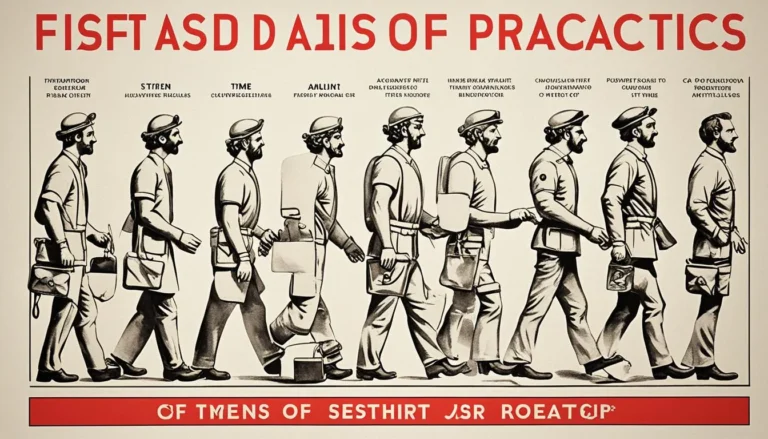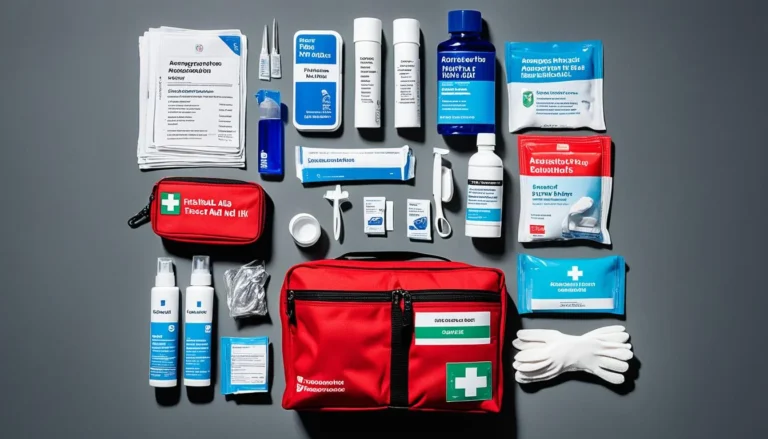Where Do Most People Keep First Aid Kit
In the United Kingdom, homes and workplaces are carefully organised for UK home safety. They make sure the emergency kit is easy to get to. The important first aid kit, full of things for emergencies, usually sits in places at home or work that are quick to reach. It’s done this way to keep everyone’s safety and the items inside safe.
A smart idea is to put the first aid kit where it fits in well and stays safe. It might be on a wall bracket within easy reach. Or it could be hidden in a kitchen cupboard or strong counter. The main goal is to choose a place that is close and keeps the kit safe.
Key Takeaways
- First aid kits should be stored in easily accessible locations.
- The installation of these kits requires consideration of UK home safety protocols.
- Emergency kit accessibility is vital in ensuring swift and effective response.
- Ideal storage preserves contents from environmental damage.
- Mounting kits to the wall or storing them in cabinets are prevalent practices.
- Visibility, through signposting or strategic placement, is essential for locating kits promptly.
Understanding the Importance of Accessible First Aid Kits
In today’s work settings, quick access to first aid kits is vital. It’s more than just a rule.
Workplace first aid laws demand that first aid supplies are near and easy to get to.
The availability of first aid kits plays a key role in handling emergencies well.
The Essentials of Workplace First Aid Compliance
For businesses, following first aid rules is crucial. They need to ensure every worker can use a first aid kit within a minute. Doing this sharply lowers the chances of serious injuries and makes the workplace safer.
Factors Influencing First Aid Kit Placement
Where first aid kits are put is very important. You need to look at where people work and what dangers are there. For buildings with many floors, having kits on each level is a smart move. They should be easy to find and reach.
It’s not just about having kits close by. They also need to be safe from things that can ruin them, like heat or dust. This keeps the supplies in the best condition.
| Location | Accessibility | Considerations |
|---|---|---|
| Office Areas | Highly Accessible | Close to workspaces, avoid direct sunlight |
| Industrial Sections | Strategically Placed | Near machinery but shielded from debris |
| Multi-Level Areas | Each Floor | At staircases or central locations |
In the end, keeping up with first aid kit rules and adapting them to the workplace is key. This leads to a safer place to work and a better response to emergencies. This directly affects how safe and well employees are.
Optimal Locations for First Aid Kits in the Workplace
It’s key to place first aid kits strategically for quick accident response. The right positioning can mean fast care instead of waiting during an emergency.
Evaluating Your Workplace Layout for Kit Accessibility
Start by looking at your work’s layout to find the best first aid kit spots. Check how long it takes to get to each kit from all areas. Each part of your space should be able to grab a first aid kit in under a minute.
Strategic Placement Based on Workplace Hazards
Where there are more dangers like machines, chemicals, or busy areas, put first aid kits closer. This helps react fast to accidents, cutting down on worse injuries from slow care.
- Place kits near doors for quick grabbing in emergencies.
- Put them close to risky areas for fast help.
- Have kits in gathering spots like break rooms.
By using these tips, you make sure your first aid kits are not only well-placed but also boost how fast and well you can respond to an accident.
Home First Aid Kit Storage Solutions
Keeping first aid kits safe at home is very important. Where we keep them can really affect how well they work when there’s an emergency. Choosing the right first aid storage solutions helps ensure the kits are easy to get to and safe from harm.
The kitchen and bathrooms are usually the best places to store first aid kits. They are easy to reach and keep the contents safe from too much heat or dampness. Plus, these places are known to everyone in the house. So, if there’s a rush to get the kit, people know where to find it.
- Make sure kids can’t reach them but adults can easily.
- Always check your first aid kit. Replace anything that’s out of date or missing.
- Keep them away from moisture and sunlight. This helps keep the items in good condition.
Below is a table with info on good first aid storage solutions. These spots are both easy to get to and safe:
| Location | Accessibility | Protection Level |
|---|---|---|
| Kitchen Cabinet | High | Moderate – Ensure away from heat sources |
| Bathroom Closet | High | High – Ensure it’s a dry area |
| Bedroom Drawer | Medium | High – Typically free from environmental risks |
By using these first aid storage solutions, your home will be safer. Plus, your first aid supplies will always be ready when you need them most.
Key Considerations for First Aid Kit Visibility
Keeping first aid kits easy to spot is crucial, especially in busy workplaces. This is key when quick responses are needed. They should be put where they’re easily seen and marked well.
The Role of Signage in Locating First Aid Kits
Signs showing where first aid kits are help everyone find them fast. They should stand out and be clear, even from far away. Signs that light up are even better because they work well even at night.
It’s important to check these signs often. Making sure they are always visible can make a big difference in an emergency. This way, the emergency procedures work smoothly.
Wall-Mounted vs Portable First Aid Kits
Deciding between wall-mounted or portable first aid kits depends on your place’s needs. Wall-mounted kits are a good choice for keeping everyone aware because they can have big signs. Here’s what to consider:
| Feature | Wall-Mounted Kits | Portable Kits |
|---|---|---|
| Visibility | High, fixed in open locations | Variable, depends on kit placement |
| Accessibility | Always accessible from mounted point | Can be brought directly to the casualty |
| Best Use Scenario | Fixed locations like offices or workshops | Flexible, crucial for fieldwork or dynamic environments |
| Signage Efficiency | Highly effective with permanent wall signs | Requires additional measures for visibility |

Portable kits offer more adaptability, while wall-mounted kits are quickly spotted with their big signs. The best pick depends on the job site and what could go wrong.
First Aid Kits in Public and Communal Spaces
Keeping public safety in mind, it’s essential to have communal area first aid resources easily available. Places where lots of people gather, like schools and sports venues, are often scenes of accidents. Therefore, it’s crucial to have first aid kits stocked and placed in visible spots for quick access. This helps deal with emergencies promptly.
It’s very important to check and update these first aid kits regularly. This way, they’re always ready to use. By replacing old or used items, the kits will work effectively when needed. In the spirit of public safety, communal areas should not only have the right first aid supplies but also teach their staff basic first aid. This combination leads to a fast and helpful reaction to health crises, making these places safer for everyone.
- High visibility and accessibility of first aid kits.
- Regular training for staff on how to use the kits effectively.
- Periodic review and replenishment of supplies to ensure readiness.
Taking a proactive approach to communal area first aid has huge benefits. It deals with health issues right away and creates a culture of safety. This work greatly improves the local welfare. By following these guidelines, communal spaces can ensure both immediate and ongoing safety for the public.
Specialised First Aid Stations and Their Advantages
Ensuring employees’ safety in today’s work settings is very important. Specialised first aid stations are a great solution. They make accessibility and emergency response better. These stations are more than just places for first aid kits. They help improve safety at work and meet strict rules on safety.
Enhanced Accessibility with First Aid Stations
Putting specialised first aid stations in key spots makes getting to emergency help quicker. This is vital when time is short. Employees can more easily get to needed first aid tools. This speeds up how fast they can help in an emergency.
Incorporating Clear Instructions at First Aid Points
During an emergency, clear instructions are key. Specialised first aid stations have easy-to-follow guides. This is a big help in making quick, effective first aid possible. Even if someone isn’t fully trained, they can use these stations well until a healthcare expert arrives.
Below is a table that highlights the typical features found in specialised first aid stations, contrasting with traditional first aid kits:
| Feature | Specialised First Aid Station | Traditional First Aid Kit |
|---|---|---|
| Accessibility | High, with multiple stations strategically located | Variable, depends on placement and awareness |
| Instructions for Use | Includes comprehensive instructions | May not include instructions |
| Contents | Extensively equipped for a variety of emergencies | Basic supplies for general use |
| Visibility | Highly visible with clear markings and signage | Often compact and not immediately noticeable |
| Maintenance | Regularly inspected and restocked | May not be regularly maintained |

Maintaining the Integrity of First Aid Supplies
Keeping first aid supplies safe and effective is vital for managing health well. It is key to check them regularly and keep them in the right environment. This helps make sure your first aid supplies are ready when needed.
Avoiding Environmental Factors That Compromise Kit Effectiveness
To keep first aid items working, shield them from bad weather and light. Warmth, dampness, and light can wreck bandages, antiseptics, and drugs. Storing them somewhere cool and dry is a must to make them last and be useful in emergencies.
Regular Checks and Replenishment of First Aid Supplies
Checking and renewing first aid supplies often is critical. Replacing used or old items is vital to maintain first aid supplies integrity. A regular check-up system ensures your kit is always ready for emergencies.
| Item | Check Frequency | Common Issues | Replacement Guideline |
|---|---|---|---|
| Bandages | Every 3 months | Loss of elasticity, seal breakage | Replace if packaging is damaged or open |
| Antiseptics | Every 6 months | Evidence of leakage or evaporation | Replace if level of liquid has decreased or seal is broken |
| OTC Medications | Annually | Expired or approaching expiration | Replace six months before expiration date |
Legal Requirements for First Aid Kits in the UK
In the UK, first aid kits are not just nice to have; they’re a must by law. Employers must make sure their workers get quick help if they’re ill or hurt on the job. These legal duties are at the heart of keeping the workplace safe. They show that bosses care about their staff’s well-being.
The Role of First-Aiders and Appointed Persons
Who takes the lead when health issues happen at work? It’s a key question covered by the law. Specifically appointed people, known as first-aiders, play a big role. They don’t just act when bad things happen; they keep first aid kits ready, make sure they’re full, and help in emergencies. Training and keeping up-to-date are crucial for their job, showing how serious it is to keep a work environment safe.
Assessing First-Aid Needs for Your Business
Every workplace is different, facing its unique set of risks. That’s why it’s crucial to figure out what first aid your business needs. This means looking at potential hazards, checking the equipment, and knowing how many first aid kits you need in different areas. This whole process is about managing risks and making sure you’re ready to care for people if something goes wrong. It’s all to keep everyone safe and the business running smoothly.

